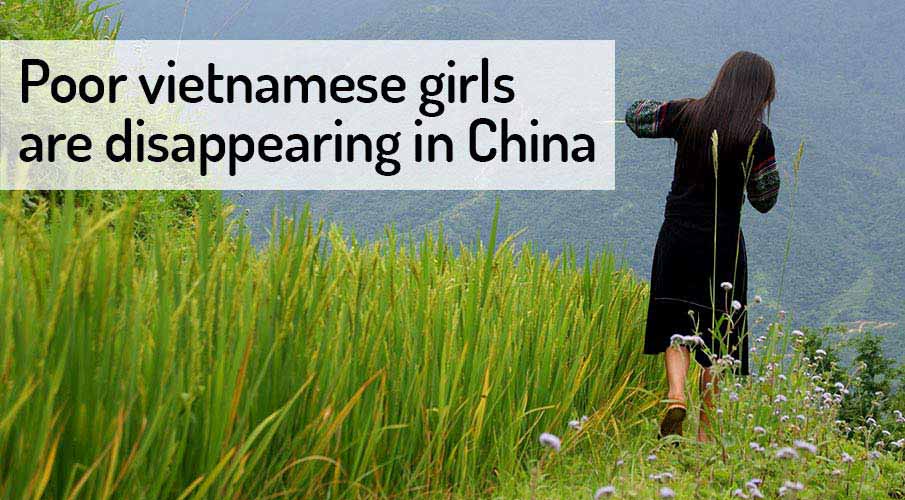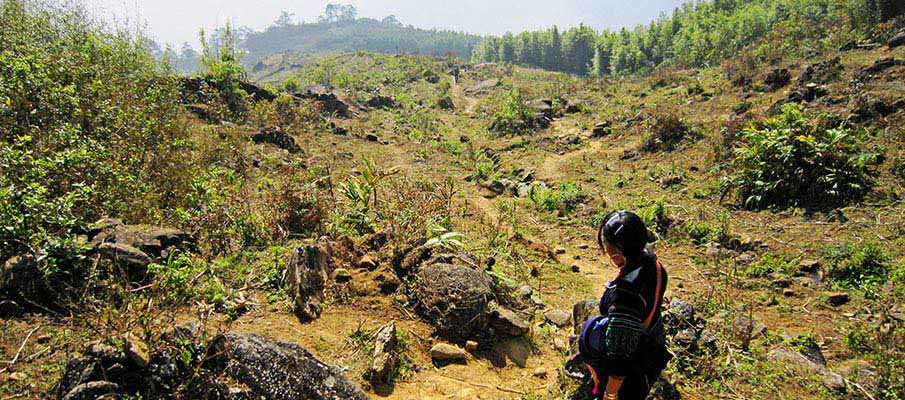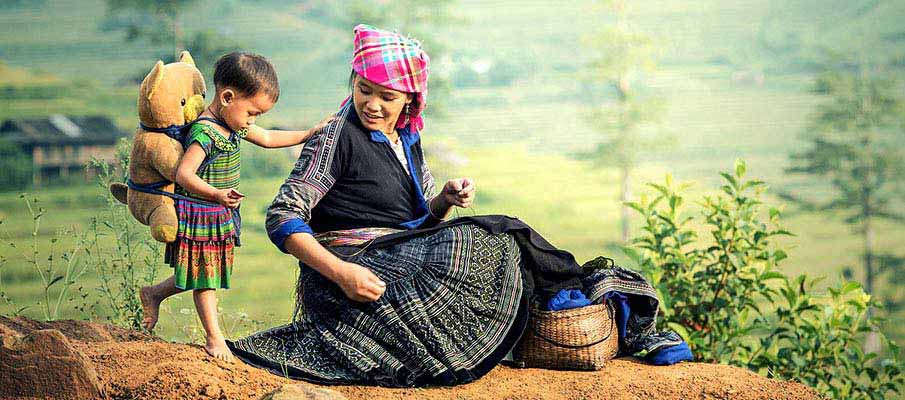
Poor Vietnamese girls are disappearing in China.
Traffickers sells them to solitary young men for brides. Vietnamese girls from Lao Cai province near the border with China are young, beautiful, poor – and vulnerable. Many of them have ended up in the hands of traffickers who have been kidnapped and taken to China. Then they sell them as brides. Because of the policy of one child practiced in the realm of the Middle Ages from the 1980s to the recent times, there is a huge lack of girls and women in marriage. A number of Chinese men therefore buy their „brides“ on the black market. Many of them come from Vietnam.
Sixteen-year-old Cam disappeared last April from its village in Lao Cai.
Sapa (Vietnam) – Sixteen-year-old Cam disappeared last April from its village in Lao Cai province in northwest Vietnam. She started out on a motorbike with a young man she had previously met through Facebook. They kidnapped her. A number of young women were similarly „vanished“ from the poor Vietnamese countryside. They ended up in the hands of the traffickers who lured them to China. They become victims of the bridegroom trade. Such girls often end up isolated in their new families as wives and mothers, but also as maids and sexual slave to other male family members. Because of the policy of one child in the family, which has been practicing in China since 1979 over 30 years, girls in the realm of the center are a huge deficiency.

Cam, who is a part of the Black Hmong ethnic group.
At a time when Chinese families had the opportunity to have only one child legally, they usually preferred boys. If it turned out that a girl was born, women often decided to abortion. In 2020, according to The Guardian, in China will live 30 million more men than women in the reproductive age. I hope you’re ready to get married. Camin´s mother Phuong had to act quickly if she wanted to see her daughter again. At her daughter’s facebook, she found a photograph of a young man, whom Cam had gone before. She let his photo grow up and went looking for him on his own. Cam, who is a part of the Black Hmong ethnic group, was born in 2000 as the third of seven siblings. Their father is a farmer, a mother who is illiterate, making a living by producing traditional cannabis-stained indigo clothing. While parents cultivate rice fields, the children are unrelated to each other.
At fifteen she signed up for Facebook and found new friends.
But she had a great deal among her siblings. Already at the age of 12, she knew English so well that she was doing tours around the surrounding mountains. Two years later she left school and started working at a hotel in Sapa at the Vietnam-Chinese border. At fifteen she signed up for Facebook. With the arrival of cheap mobile phones, Vietnam has become one of the most affiliated countries in the world. More than half of the 95 million population is on the Internet, with Facebook and YouTube being the two most popular platforms in the country. It was through Facebook that Cam communicated, found new „friends“, which eventually had about five thousand, mostly Hmongs. Ethnic groups live in a mountain belt from China through Vietnam, Laos and Thailand. There are still strict marriage traditions among Hmongs.
Somewhere on the border between Vietnam and China.
But on Facebook everyone feels free. There, too, Cam knew Long. She was able to spend hours with him. After five months of on-line contact, Cam’s 16th birthday met him personally, and then several times before Long stopped. Suddenly he was inaccessible. After some time, Cam’s Long’s younger brother, Binh, contacted Cam through Facebook. They agreed that in the evening they would go out with Cam’s and Binh’s friend in four. In the restaurant they gave a couple of beers. The last thing Cam recalled later was that she was sitting on a motorbike between two men and dizzy. The inscriptions on the streets were all in Chinese, the trio was somewhere on the border between Vietnam and China. Cam pulled out her cell phone and called her sister for kidnapping her. But one of the men pulled her phone out of her hand and put her knife on her neck.

Cam is glad that the traffickers were finally convicted.
„You’re in China, you can not go home,“ he told her. „I hope you’re ready to get married, because you’re going to do it soon.“ But in the end, Cam was fortunate. Her mother Phuong found her after a few days. Using Long’s photos, she searched for his and Binh’s father and persuaded him to help her family help her daughter look for her. Nearly in the middle of a hotel with a Vietnam-based Hmong couple, who had wanted to buy her from the traffickers, they had familiarized them about. However, the store met. The three men who kidnapped Cam, the police fell, and this June, the court sent them to prison for 12 to 25 years. Binh, who dragged her into the trap, but was not among them. Cam is glad that the traffickers were finally convicted. Still, they are afraid of Binh’s revenge. „I want the police to catch him so I can calm down and have a normal life.“
What is the price of the bride on the black market?
There are millions of men in China who do not have a chance to find their wife in a legal way. On the black market, a woman can buy about 80,000 yuan (about 12 300 USD). The exact figures on how many Vietnamese girls disappear every year without a trace in China and how many they can save are not available. The border between Vietnam and China is too permeable and the police budgets for its security are small. The rescue of girls also depends on the Chinese authorities‘ cooperation with the Vietnamese, which is not always the case. Many families, like Cam’s Mother Phuong, search for their daughters on their own. For example, in 2012, according to Chinese authorities, 1281 women were returned home. It was mainly girls from Vietnam, Burma, Laos. In 2016, Chinese police freed 207 Vietnamese women and girls from cross-border brides. There were 61 gangs in the area. Only for this June, 18 Chinese girls have returned to Lao Cai province. That’s just the tip of the iceberg. Thousands of Hmong girls remain in the China’s family, nothing is known about their fate. Last year, in October, only 12-year-old Vietnamese had been outraged, sold to the 35-year-old Chinese for 30,000 yuan (about 5000 USD). The girl soon became pregnant.

Poor education, poverty and puberty.
The frontier province of Lao Cai, where most of the Vietnamese brides come from, is one of the poorest and most ethnically diverse areas of Vietnam. There are many illiterate people among mountain tribes. „There are many reasons why trafficking of human beings in this region is so widespread: poor education, poverty, puberty,“ says Nguyen Tuong Long of the Provincial Prevention Department in charge of preventing trafficking of human beings and helping victims.
Traffickers targets are not only girls, but also boys to help girls attract them. This was obviously the job of young Long of Cam’s story. These guys do not understand that they help the traffickers. They just want to make some money. „I’ve talked to many boys who are doing it, I asked them why.“ I wanted a new iPhone, „one of them said to me,“ sums up Nguyen Tuong Long.

Nha Trang|Phu Quoc|MuiNe|DaLat|P.Penh|S.Reap|Vientiane|L.Prabang|DaNang|Hoi An|TrangAn|Hoi An|Saigon|Cat Ba|Hue|Sapa|Kong